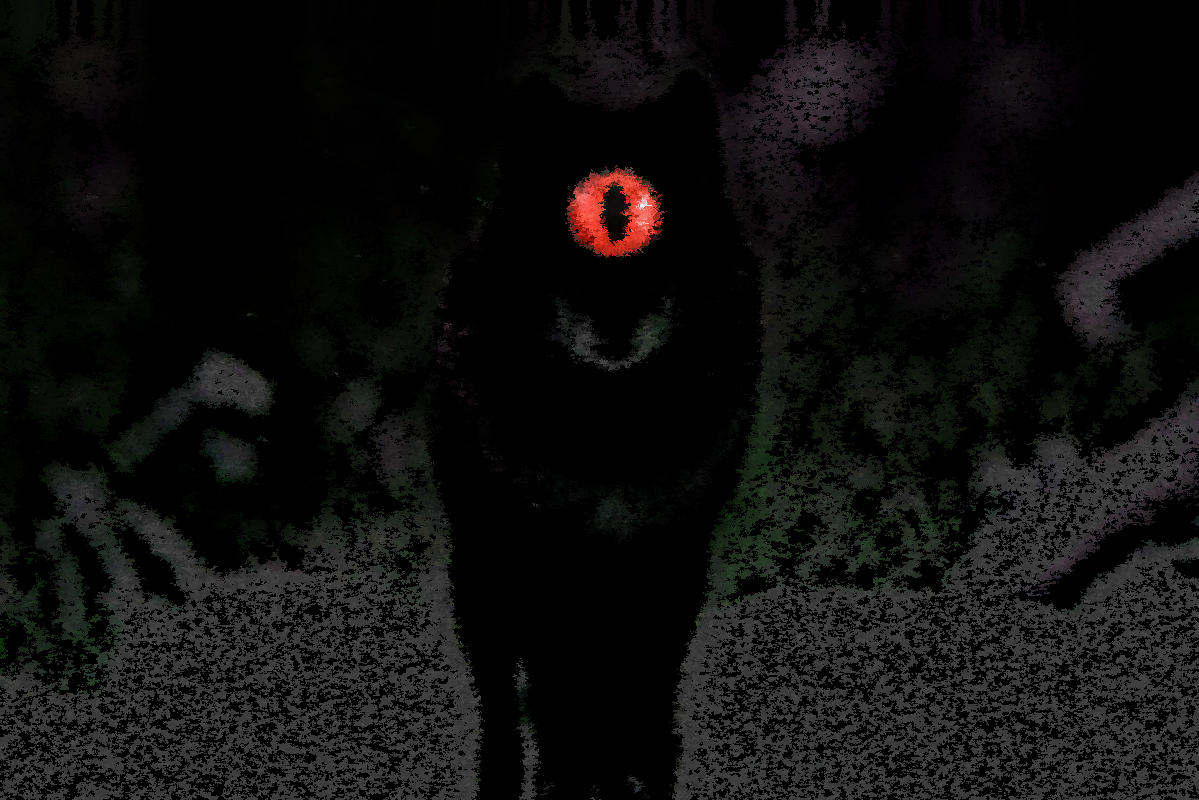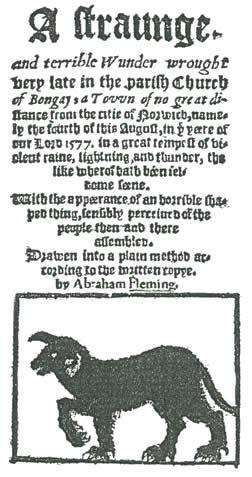Black Shuck on:
[Wikipedia]
[Google]
[Amazon]
In
 Dr Simon Sherwood suggests that the earliest surviving description of devilish black hounds is an account of an incident in the
Dr Simon Sherwood suggests that the earliest surviving description of devilish black hounds is an account of an incident in the
 One of the most notable reports of Black Shuck is of his appearance at the churches of Bungay and
One of the most notable reports of Black Shuck is of his appearance at the churches of Bungay and
English folklore
English folklore consists of the myths and legends of England, including the English region's mythical creatures, traditional recipes, urban legends, proverbs, superstitions, and folktales. Its cultural history is rooted in Celtic, Christia ...
, Black Shuck, Old Shuck, Old Shock or simply Shuck is the name given to a ghostly black dog which is said to roam the coastline and countryside of East Anglia, one of many such black dogs recorded in folklore across the British Isles. Accounts of Black Shuck form part of the folklore
Folklore is shared by a particular group of people; it encompasses the traditions common to that culture, subculture or group. This includes oral traditions such as tales, legends, proverbs and jokes. They include material culture, ranging ...
of Norfolk
Norfolk () is a ceremonial and non-metropolitan county in East Anglia in England. It borders Lincolnshire to the north-west, Cambridgeshire to the west and south-west, and Suffolk to the south. Its northern and eastern boundaries are the No ...
, Suffolk, the Cambridgeshire
Cambridgeshire (abbreviated Cambs.) is a county in the East of England, bordering Lincolnshire to the north, Norfolk to the north-east, Suffolk to the east, Essex and Hertfordshire to the south, and Bedfordshire and Northamptonshire to the ...
Fens and Essex
Essex () is a county in the East of England. One of the home counties, it borders Suffolk and Cambridgeshire to the north, the North Sea to the east, Hertfordshire to the west, Kent across the estuary of the River Thames to the south, and Grea ...
, and descriptions of the creature's appearance and nature vary considerably; it is sometimes recorded as an omen of death, but, in other instances, is described as companionable.
According to the ''Oxford English Dictionary
The ''Oxford English Dictionary'' (''OED'') is the first and foundational historical dictionary of the English language, published by Oxford University Press (OUP). It traces the historical development of the English language, providing a co ...
'', the name ''Shuck'' derives from the Old English
Old English (, ), or Anglo-Saxon, is the earliest recorded form of the English language, spoken in England and southern and eastern Scotland in the early Middle Ages. It was brought to Great Britain by Anglo-Saxon settlers in the mid-5th c ...
word 'devil, fiend', perhaps from the root 'to terrify'. The first mention in print of "Black Shuck" is by Reverend E. S. Taylor in an 1850 edition of the journal ''Notes and Queries
''Notes and Queries'', also styled ''Notes & Queries'', is a long-running quarterly scholarly journal that publishes short articles related to " English language and literature, lexicography, history, and scholarly antiquarianism".From the inne ...
'' which describes "Shuck the Dog-fiend"; "This phantom I have heard many persons in East Norfolk, and even Cambridgeshire, describe as having seen as a black shaggy dog, with fiery eyes and of immense size, and who visits churchyards at midnight."
Abraham Fleming's account of the appearance of ''A strange, and terrible wunder'' in 1577 at Bungay, Suffolk is a famous account of the beast. Images of sinister black dogs have become part of the iconography of the area and have appeared in popular culture
Popular culture (also called mass culture or pop culture) is generally recognized by members of a society as a set of practices, beliefs, artistic output (also known as, popular art or mass art) and objects that are dominant or prevalent in a ...
. Writing in 1877, Walter Rye stated that Shuck was "the most curious of our local apparitions, as they are no doubt varieties of the same animal."
Descriptions
Descriptions of Black Shuck vary in both shape and size, from that of a large dog to being the size of a calf or horse. W. A. Dutt, in his 1901 ''Highways & Byways in East Anglia'' describes the creature thus: Dr Simon Sherwood suggests that the earliest surviving description of devilish black hounds is an account of an incident in the
Dr Simon Sherwood suggests that the earliest surviving description of devilish black hounds is an account of an incident in the Peterborough Abbey
Peterborough Cathedral, properly the Cathedral Church of St Peter, St Paul and St Andrew – also known as Saint Peter's Cathedral in the United Kingdom – is the seat of the Anglican Bishop of Peterborough, dedicated to Saint Peter, Saint Pau ...
recorded in the Peterborough Chronicle
The ''Peterborough Chronicle'' (also called the Laud manuscript and the E manuscript) is a version of the ''Anglo-Saxon Chronicles'' originally maintained by the monks of Peterborough Abbey in Cambridgeshire. It contains unique information abo ...
(one version of the '' Anglo-Saxon Chronicle'') around 1127:
This account also appears to describe the Europe-wide phenomenon of a Wild Hunt
The Wild Hunt is a folklore motif (Motif E501 in Stith Thompson's Motif-Index of Folk-Literature) that occurs in the folklore of various northern European cultures. Wild Hunts typically involve a chase led by a mythological figure escorted by ...
.
Bungay and Blythburgh
 One of the most notable reports of Black Shuck is of his appearance at the churches of Bungay and
One of the most notable reports of Black Shuck is of his appearance at the churches of Bungay and Blythburgh
Blythburgh is a village and civil parish in the East Suffolk district of the English county of Suffolk. It is west of Southwold and south-east of Halesworth and lies on the River Blyth. The A12 road runs through the village which is split ...
in Suffolk. On 4 August 1577, at Blythburgh, Black Shuck is said to have burst in through the doors of Holy Trinity Church to a clap of thunder. He ran up the nave, past a large congregation, killing a man and boy and causing the church steeple
In architecture, a steeple is a tall tower on a building, topped by a spire and often incorporating a belfry and other components. Steeples are very common on Christian churches and cathedrals and the use of the term generally connotes a religi ...
to collapse through the roof. As the dog left, he left scorch marks on the north door which can be seen at the church to this day.
The encounter on the same day at St Mary's Church, Bungay
St Mary's Church is a redundant Anglican church in the town of Bungay, Suffolk, England. The church and the ruins of the adjacent priory are recorded in the National Heritage List for England as a designated Grade I listed building, and ar ...
was described in ''A Straunge and Terrible Wunder'' by Abraham Fleming in 1577:
Fleming was a translator and editor for several printing houses in London, and therefore probably only published his account based on exaggerated oral accounts. Other local accounts attribute the event to the Devil
A devil is the personification of evil as it is conceived in various cultures and religious traditions. It is seen as the objectification of a hostile and destructive force. Jeffrey Burton Russell states that the different conceptions of ...
(Fleming calls the animal "the Divel in such a likeness"). The scorch marks on the door are referred to by the locals as "the devil’s fingerprints", and the event is remembered in this verse:
Dr David Waldron and Christopher Reeve suggest that a fierce electrical storm recorded by contemporary accounts on that date, coupled with the trauma of the ongoing Reformation
The Reformation (alternatively named the Protestant Reformation or the European Reformation) was a major movement within Western Christianity in 16th-century Europe that posed a religious and political challenge to the Catholic Church and in ...
, may have led to the accounts entering folklore.
Littleport
Littleport, Cambridgeshire is home to two different legends of spectral black dogs, which have been linked to the Black Shuck folklore, but differ in significant aspects: local folklorist W.H. Barrett relates the story of a huge black dog haunting the area after being killed rescuing a local girl from a lustful friar in pre-reformation times, while fellow folklorist Enid Porter relates stories of a black dog haunting the A10 road after its owner drowned in the nearby River Great Ouse in the 1800s.In popular culture
British rock band The Darkness have a song called "Black Shuck" on their 2003 debut album ''Permission to Land
''Permission to Land'' is the debut studio album released by British glam rock band the Darkness. The album was released in the United Kingdom on 7 July 2003 and in the United States on 16 September 2003. The album topped the UK Albums Chart an ...
''.
In '' Teen Wolf'', an ancient Hellhound spirit that had possessed someone, tells one of the main characters that it is known by many names, one of which is "Black Shuck".
British rock band Down I Go
Down I Go are an experimental hardcore band from London.
Their music combines complex song structure and rhythmic patterns with both melodic and screaming vocals, as well as frequently marrying these features with orchestral instrumentation ...
have a song called "Black Shuck" on their 2019 EP 'All Down the Church in Midst of Fire the Hellish Monster Flew, and Passing Onward to the Quire, He Many People Slew'.
In June 2019, after being previously crowdfunded on Kickstarter, the graphic novel ''The Burning Black: Legend of Black Shuck'' was published by Renegade Arts Entertainment. The book was written by Mark Allard-Will, with artwork by Ryan Howe and lettering by Elaine M. Will. The graphic novel features Black Shuck as its central antagonist.
The Black Shuck appears in the 2020 video game '' Assassin's Creed: Valhalla'' as a mini boss encountered while exploring the countryside of East Anglia. The player can find it eating a carcass amidst a ruined building, and when killed it gives the player a skill point and its decapitated head.
The Black Shuck appears in Rahel Kapsaski's 2020 stop-motion animated folk horror film ''Curse of the Black Shuck'' released by Troma
Troma Entertainment is an American independent film production and distribution company founded by Lloyd Kaufman and Michael Herz in 1974. The company produces low-budget independent films, primarily of the horror comedy genre. Many of them pl ...
.
Black Shuck is a track with 'knot-in-the-stomach insistent strings' on These Feral Lands Volume 1, a 2020 release by musician Laura Cannell, comedian Stewart Lee and others.
Satirical, comedic, theatrical string quartet Bowjangles feature a song about Black Shuck composed by Norfolk-born ensemble member Bertie Anderson in the recording of their stage show ''Excalibow'', in keeping with the overall theme of myths and legends.Sleeve notes of the CD of the show ''Excalibow''.
See also
* Barghest *Black dog (ghost)
The black dog is a supernatural, spectral, or demonic entity originating from English folklore that has also been seen throughout Europe and the Americas. It is usually unnaturally large with glowing red or yellow eyes, is often connected with ...
* Black dog ghosts in popular culture
* Shug Monkey
References
{{Spectral Black Dogs English legendary creatures Mythological dogs Mythological canines Cambridgeshire folklore Essex folklore Lincolnshire folklore Norfolk folklore Suffolk folklore Suffolk Coastal